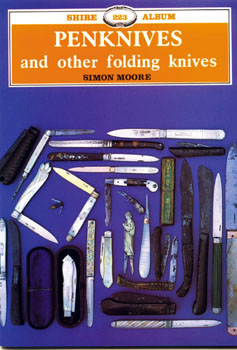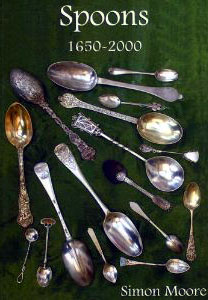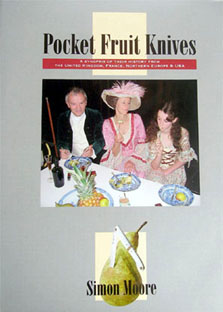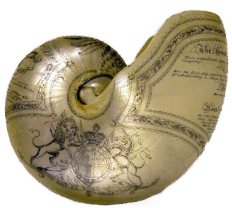Staff background
Simon Moore M.I.Sc.T., A.C.R.
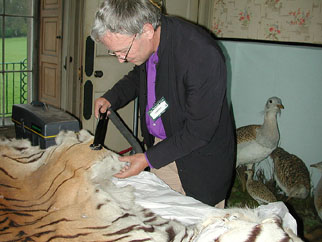
You can contact Simon at: couteaufin@btinternet.com
Simon joined the
British Museum (Natural History) in February 1968, in the newly-expanded Histology and Preservation
(Conservation) section. He was responsible for preparing and maintaining material in the Comparative Anatomy Collection
and all the fluid-preserved material on public display. He was also responsible for preparing and examining material using both
Scanning and Transmission Electron Microscopes.
He learned newly-developed techniques for fluid-preserving zoological specimens and specimen freeze-drying
from the late RH Harris. In 1972 he obtained a City & Guilds of London Institute in Histology with credit
and became a Member of the Institute of Science Technology. Later he also became responsible for the curation and
identification of coelenterates to worldwide level.
In June 1991 he left to become Conservator of Natural Sciences for Hampshire
County Council Museums Service. Here he became
responsible for the preparation and conservation of biological and geological specimens in
the collections and exhibitions
of registered Hampshire Museums and by contract for other local authority and national museums.
Since June 1992 he has enjoyed an additional role as Adviser and Conservator of Natural
Sciences to the National Trust.
Simon retired from Hampshire County Council Museums Service in November 2009 and is now a freelance conservator full-time.
He is still very much available for presentations, advice, training, preventive and remedial conservation work just the same as ever.
Simon was editor of the newsletter of the newly-formed Natural Sciences Section of
UKIC (United Kingdom Institute for Conservation of Historic and Artistic Works, now ICON),
from its inception in 1993 and continued in this role when it changed in 1995 to the
"Natural Sciences Conservation Group". He gave up this role in 1997,
since when he has been a committee member.
He was then instrumental in initiating and supervising the convergence of the Biology Curators’
Group with the Natural Sciences Conservation Group in 2002 to create the Natural Sciences Collections Association
(NatSCA), and continues to ‘beat the drum’ on behalf of natural
history conservators on the NatSCA Committee. He resigned as Chair of the NCCR’s PSB Committee after their last
meeting in 2004 when the NCCR converged to become the Institute of Conservation (ICON).
Since 1994 Simon has trained many curators and conservators in fluid preservation techniques and the mainenance of such collections. In 2006 he gave his first formal fluid preservation four day course to an international class in Oxford and has since run over 10 such courses including one in French (Paris 2008).
In 2010 there will be another such course in April (date and venue to be fixed.)
Over the past two years he has also given courses in basic taxidermy cleaning and maintenance, and will run another in February 2010 on the care and maintenance of cased taxidermy specimens at Colchester Museum.
In October 2010 he will also running similar courses in Paris on Herbarium care and maintenance, and another on the care and repair of dried entomological specimens at the Institut National Patrimoine (St Denis, Paris). In 2011 he plans a similar venture in Paris on taxidermy care and maintenance.
Simon gave eye-opening courses in 2004 to National Trust curators and
conservators at Calke Abbey and Overbecks (Devon), raising awareness of the
problems beset by Natural History Specimens. He will be leading another similar course at Tyntesfield House near Bristol in January 2010.
He has given many courses to volunteers and staff of various museums on
specimen cleaning and pest awareness,
and was trained in geological conservation by Chris Collins in 1992.
From 1998 to 2000 Simon was a Committee member for
UKIC (now ICON) Fast Track Accreditation. He was himself accredited by
this route, becoming ACR in June 1999. In January 2001 he was elected
"Chair of Professional Standards Board
of the National Council for Conservator-Restorers". Since October 2000
he has been a part-time lecturer and examiner
for Bournemouth University's Museum and Heritage Studies course to
Bsc and Msc students.
1 A technique for the histological preparation of spiders. Journal of Science Technology, 17 (2): 13-17 (1973).
2 Some spider organs as seen by the SEM, with special reference to the book lung. Bulletin of British Arachnological Society, 3 (7): 177-187 (1976).
3 Some notes on freeze-drying spiders. Bulletin of British Arachnological Society, 4 (2): 83-88 (1977).
4 Restoration of the Quekett microscope slide collection. Microscopy, 33: 489-494 (1979).
5 Problems with glass museum jars solved. Biology Curators' Group Newsletter, 2 (8): 384-389 (1980).
6 Morphological variation in the hydromedusa Calycopsis borchgrevinki. Cahiers de Biologie Marine, 25: 245-256 (1984).
7 Re-description of the leptomedusan Blackfordia virginica. Journal of the Marine biological association of the United Kingdom, 67: 287-291 (1987).
8 A gravimetric method of distinguishing between spirit and formalin. Biology Curators' Group Newsletter, 4 (5): 113 (1987).
9 A new species of cubomedusan from Northern Australia. The Beagle, 5 (1): 1-4.
10 Conservation of spirit specimens. In Conservation of Natural History Specimens. Manchester Museum. (1989a).
11 Narcotising sea anemones. Journal of the Marine biological association of the United Kingdom, 69 (4): 803-811 (1989b).
12 Investigation into the preservation of the ET Browne collection of hydromedusae. Journal of the Marine biological Association of the United Kingdom, 70 : 477-480 (1990). [Reprinted in Conservation News 53: 40-41 (1994).
13 Relative humidity and temperature for display and storage of biological specimens. In Standards in the Museum Care of Biological Collections. Museum and Galleries Commission, London (1992a).
14 Freeze drying spiders. Life after Death, UKIC symposium publication (1992b).
15 Book review: Biology in the Conservation of Works of Art. (ICCROM) Conservation News, 51: 22-23 (1993a).
16 Cryo-resistant fluids in biological specimens: lyophilo-resistance. Conservation News, 51: 38 (1993b).
17 Problems encountered in maintaining fluid-preserved specimens. Conservation News, 51: 38-39 (1993c).
18 Conservation Unit-funded study tour to USA and Canada. Conservation News, 52: 39-40 (1993d).
19 Bones - to degrease or not to degrease? Conservation News, 52: 40-41 (1993e).
20 Restoration of Oates bird case, use of almond oil and Eulan WA. Conservation News, 52: 41 (1993f).
21 SPNHC Conference, Victoria June, 1993: Flood Disaster at Texas A&M University. Biology Curators' Group Newsletter, 6 (3): 31-33 (1994a).
22 What fluid is in this bottle? Biology Curators' Group Newsletter, 6 (4): 44-45 (1994b).
23 Fluid-preserved collections: topping up sealed containers. Conservation News, 54: 38-39 (1994c).
24 The Romsey Hoopoe - a case for feather restoration? Conservation News, 54: 38 (1994d).
25 Repair of damaged spirit-preserved specimens - giving the needle. Conservation News, 56: 24 (1995a).
26 Why not just call it a house sparrow? Journal of the Guild of Taxidermists, 25: 14-15 (1995b).
27 [With RE Rau] Restoring old mammal mounts (Munich Quagga). Conservation News, 57: 22-25 (1995c).
28 A mycoherbarium for Hampshire. Natural Sciences Conservation Group Newsletter, 1: 8-13 (1996a).
29 Book review: Storage of Natural History Collections: a preventive conservation approach . Natural Sciences Conservation Group Newsletter, 3: 18-19 (1996b).
30 Cambridge 1996 - The International Congress - an overview. Natural Sciences Conservation Group Newsletter, 4: 13-15 (1996c).
31 Are we relying too heavily on computers? (For recording data, writing labels). Natural Sciences Conservation Group Newsletter, 4: 17 (1996d).
32 Narcotising sea anemones. Natural Sciences Conservation Group Newsletter, 5: 10-20 (1997a).
33 Phenoxetol: friend or foe? (A personal history). Natural Sciences Conservation Group Newsletter, 6: 24-25 (1997b).
34 Fly orchid aberration? Another record. BSBI News, 76: 21-22 (1997c).
35 The Conservation Forum Insurance Seminar. Natural Sciences Conservation Group Newsletter, 7: 5-6 (1998a).
36 Pests - some less usual occurrences. Insert to Natural Sciences Conservation Group Newsletter, 7 (1998b).
37 Hardiness of Anthrenus beetle. Natural Sciences Conservation Group Newsletter, 8: 27 (1998c).
38 Fluid Preservation. In: Care and conservation of Natural History Collections. Eds DJ Carter & A Walker. Butterworth & Heinemann, Oxford.
39 Deodorising skeletal material. Natural Sciences Conservation Group Newsletter, 10: 24-25.
40 Humitemp conditioning for biological collections at Hampshire Museums Service. Natural Sciences Conservation Group Newsletter, 10 (1999c).
41 Dust. Natural Sciences Conservation Group Newsletter, 11: 7-8 (2000a).
42 Two conservation problems. Natural Sciences Conservation Group Newsletter, 13: 9-10 (2000b).
43 BCG trip to Budapest Natural History Museum, October 2000. Natural Sciences Conservation Group Newsletter, 16: 22-24 (2000c).
44 Transferring biological specimens from formalin to alcohol. Natural Sciences Conservation Group Newsletter, 17: 43-45.
45 Museum rescue - saving disposed and de-accessioned material. Natural Sciences Conservation Group Newsletter, 18: (in press).
46 Two talks from seminar Fluid preservation - do we really understand it? History of fluid preservation. Histological effects of fixation and long-term preservation. Preservatives - are they beneficial or not? Natural Sciences Conservation Group Newsletter, 18:(in press).
47 Museum Rescue: saving de-accessioned and material for disposal. Natural Sciences Conservation Group Newsletter 18: 14-15. 2002.
48 A brief history of fluid preservation with some basic facts about it including labels and inks. Natural Sciences Conservation Group Newsletter 18: 21-24. 2002.
49 Histological effects of fixation and long-term preservation – are preservatives beneficial or not? Natural Sciences Conservation Group Newsletter 18: 24-26. 2002
50 The hardiness of Anthrenus 2. Natural Sciences Conservation Group Newsletter 19: 21. 2002
51 Natural Sciences Conservation in the UK. NatSCA News 1: 42-43. 2003
52 Solving fungal problems in heritage collections – review. NatSCA News 2: 34-35. 2004
53 Potter’s museum of curiosities, a personal recollection. NatSCA News 3: 56. 2004.
54 MOORE, S. J. 2004e: Ol Yellow Belly: a problem with stoat ventral fur. NatSCA News, 4: 31.
55 MOORE, S. J. 2004f: Cleaning dusty feathers, a technique that works! NatSCA News, 4: 32-33.
56 MOORE, S. J. 2004g: Removing pooled fat and mothproofing freeze-dried mammals by perfusion. NatSCA News, 4: 33-34.
57 MOORE, S. J. 2005a: Repair of a foetal elephant’s foot at the Cole Museum, Reading University. NatSCA News, 5: 21-24.
58 MOORE, S. J. 2005b: The origins of NatSCA- a personal history. NatSCA News, 4: 31.
59 MOORE, S. J. 2005c: Natural History Collections. In: Manual of Housekeeping, (Ed. Cronyn, J). The National Trust, Elsevier, London.
60 MOORE, S. J. 2005d: Poster review and extra information from the SPNHC NatSCA Conference 2005. NatSCA News, 6: 46-48.
61 MOORE, S. J. 2005e: Use of Japanese tissues in repair of natural science specimens. NatSCA News, 7: 8-14.
62 MOORE, S. J. 2005f: Problems with lipid and fluid-preserved specimens. NatSCA News, 7: 14-15.
63 MOORE, S. J. 2006a: Conserving transparencies (specimens). NatSCA News, 8: 12-14.
64 MOORE, S. J. 2006b: The mycoherbarium at Hampshire County Council Museums Service: storage and preparation issues. NatSCA News, 9: 4-5.
65 MOORE, S. J. 2006c: A personal review of the Liverpool Conference. NatSCA News, 9: 49-51.
66 MOORE, S. J. 2006d: Book review for A guide to the restoration of antique taxidermy specimens .Rex Merchant. NatSCA News, 9: 52.
67 MOORE, S. J. 2006e: Overcoming problems with resin (embedment preparation) blocks. NatSCA News,10: 17-21.
68 MOORE, S. J. 2007a: Japanese Tissues: uses in repairing natural science specimens. Collection Forum 21 (1): 126-132.
69 MOORE, S. J. 2007b: Overview of the NatSCA Biochemistry Seminar. NatSCA News,11 : 25-27.
70 MOORE, S. J. 2007c: Old jar sealants. NatSCA News,12 : 20-22.
71 MOORE, S. J. 2007d: INP, Table Ronde, Grande Galérie d’Evolution, Paris, December 2006 (review). NatSCA News,12 : 42-44.
72 MOORE, S. J. 2008: Updates on computer printer inks and papers for internal labelling of fluid-preserved specimens. NatSCA News, 14: 36-40.
73 MOORE, S. J. 2009a: The future of fluid preservation 'fixation in the balance: the case for using formalin'. NatSCA News, 16: 18-21.
74 MOORE, S. J. 2009b: Adhesives for fluid-preserved specimens. NatSCA News, 16: 32-35.
75 MOORE, S. J. 2009c: SPNHC Conference in Leiden, 2009. NatSCA News, 18: 36-44.
76 MOORE, S. J. 2009d: Carpet beetle and other insect pest infestation relating to bird re-feathering and repair. NatSCA News, 18: 49-52.
77 MOORE, S. J. 2010a: Preservation of Botanical specimens in fluid. NatSCA News, 19: 85-88.
78 MOORE, S. J. 2013: An adhesive for alcohol-preserved biological specimens. Journal of Institute of Science Technology, Summer 2013: 24-28.
79 MOORE, S. J. 2015: Cleaning the fur of taxidermy specimens. In The conservation of hair. Eds. L. Bacon, V. Purewal, E. Kingham and D. Phipps. Archetype Publications, London.
Publications Simon has written on additional subjects include books on the history of British table and pocket cutlery:
Cutlery for the Table (Hallamshire Press, 1999)
Table Knives and Forks (Shire Album, 2006)
Penknives and other Folding Knives (Shire Album, 1988)
Spoons: 1650 - 2000 (Shire Album, 2005)
Pocket Fruit Knives (Antique Knives Ltd, 2008)
Simon has also contributed to:
"The Dictionary of Art" (Macmillan)
"Mesters to Masters" - a History of Sheffield cutlers (Oxford University Press).


